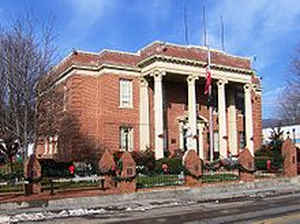Hancock County, Tennessee
Hancock County Education, Geography, and History

Hancock County is a county located in the state of Tennessee. Based on the 2010 census, the population was 6,819, making it the fourth-least populous county in Tennessee. Its county seat is Sneedville.
Etymology - Origin of Hancock County Name
Named in honor of John Hancock (1737-1793), president of the Continental Congress, first signer of the Declaration of Independence, Revolutionary War militia officer, governor of Massachusetts.
Demographics:
County QuickFacts: CensusBureau Quick Facts
History of Hancock County
Created 1844 from Hawkins and Claiborne counties; named in honor of John Hancock (1737-1793), president of the Continental Congress, first signer of the Declaration of Independence, Revolutionary War militia officer, governor of Massachusetts.
Hancock County was formed in 1844 from Claiborne and Hawkins counties. (Acts of Tennessee 1843-44, Chapter 71).
There were fires at the Hancock County courthouse in 1885 and 1930.
Tennessee Encyclopedia of History and Culture
One of the earliest settlement areas in Tennessee is Hancock County. In a 1673 letter to John Richard of London,
Abraham Wood reported James Needham and Gabriel Arthur's journey into the area: "Eight dayes jorny down this river
lives a white people which have long beards and whiskers and weares clothing, and on some ye other rivers lives a
hairey people." In 1784 John Sevier recorded in his journal that his party encountered white men in the same region
and that they had been living there for some time. The word used to describe these people was "Melungeon," initially
thought to be derived from the French word "melange," meaning mixture (as in mixed breed). The Melungeons spoke
broken English and possessed English surnames but claimed to be Portuguese. Despite their insistence on their
origins, the Scots-Irish settlers declared them "persons of color" and quickly confiscated their land. Denied access
to legal recourse, education, or other advantages of citizenship, the Melungeons withdrew to the most isolated,
least desirable mountain locales. Today, thousands of Appalachian people trace their ancestry to the Melungeons. The
names most frequently associated with the Melungeons are Collins, Mullins, Goins, Gibson, Denham, Bowlin, and
Sexton.
As Anglo-Europeans arrived in the area, the first settlers included Joseph Lamb, Jonas Lockmiller, John Ray, Enos
Matthais, William McCully, and Daniel Slavins. The first settlers were joined by families with the following
surnames: Greene, Purkey, Bray, Cantwell, Trent, Mitchell, Amis, Boulden, Anderson, Bryant, Campbell, McGhee, Mills,
Ramsey, Winkler, Wilder, Jarvis, and Wallen. The earliest ministers were John Givens, Moses Williams, and Zachariah
Seal. Initial settlement occurred in the area surrounding Greasy Rock, a large stone that protruded into a creek
that ran into the Clinch River. The rock acquired its name because it was used by hunters to clean game. Find more from the Tennessee Encyclopedia of History and Culture:
HANCOCK COUNTY
Geography: Land and Water
As reported by the Census Bureau, the county has a total area of 224 square miles (579 km2), of which 222
square miles (576 km2) is land and 1 square miles (3 km2) (0.54%) is water.
Neighboring Counties
Bordering counties are as follows:
- Lee County, Virginia (north)
- Scott County, Virginia (northeast)
- Hawkins County (east)
- Grainger County (southwest)
- Claiborne County (west)
Education







